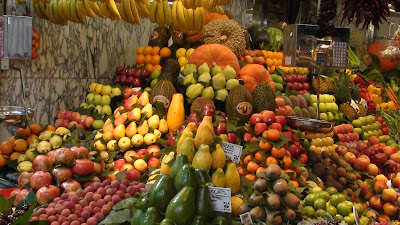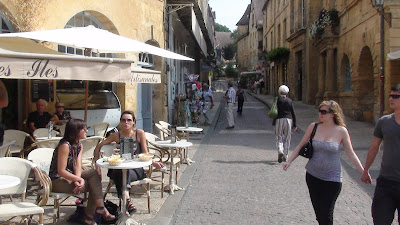Wednesday, September 14th
The big adventure for the day today is a 15 km canoe excursion on the Dordogne River from Vitrac downstream back to Beynac. Fueled with a breakfast of muesli and cafe-creme, we joined Charlie and Ellen from our travel group, and walked across the street from the hotel to the canoe office. The sign in the window specified that they expected you to arrive a minimum of twenty minutes before the 10 o'clock first departure. It was only 9:30, so we were not surprised to find that the office was not open yet. Two other women who wanted to rent canoes arrived about a quarter of the hour. However, when nobody had shown up by 9:55 I began to worry that we were supposed to have showed up at Vitrac instead of meeting here in Beynac.
I scurried back across the street to the hotel office, and asked the helpful lady at the desk to call the reservation number for the canoes to see if we were in the wrong place. She assured me that someone would be arriving to pick us up promptly at 10:00. Sure enough, it was 9:59 when a small bus whipped into the parking lot motioning to the six of us to climb aboard.
It was about a 25 minute ride on tree-lined country roads to the riverside canoe livery at Vitrac. An Australian hippy-type guy gave us a cheery greeting, and issued us life jackets and paddles. He slung a couple of canoes to slide down the river bank. Charlie and Ellen were the first to shove off, and Jane and I followed only about a minute later.
 Paddling leisurely downstream with the gentle current, we caught up with our fellow river travelers. We passed campgrounds and other canoe rental places along the way as we drifted down the Dordogne.
Paddling leisurely downstream with the gentle current, we caught up with our fellow river travelers. We passed campgrounds and other canoe rental places along the way as we drifted down the Dordogne. In some places the banks were low, and flat farmland and vineyards stretched off to rolling hills in the near distance. The river meandered closer to the hills and the low banks became chalky cliffs.
We paddled past the Chateau Castelnaud high on a promontory above us where we could see the reconstructed silhouettes of several trebuchets, looking as if they were ready to hurl skull-sized boulders at us far below.
There were openings and caves visible as we approached the village Roc de Gageac. Sandwiched between the river and the vertical cliffs, the buildings and houses almost seem stacked on top of each other, and those that nestle up against the cliffs used the cliff itself as the rear wall.
High above the last of the houses, a steep stairway juts out from the cliff, ascending to an opening halfway to the top where you can see masonry walls have been erected. We had read that village inhabitants long ago had used ropes, pulleys, and ladders to evacuate people and possessions to these high retreats in times of threat.
We pulled the two canoes up on the gravel bank opposite the village, and sat on our life jackets while we shared sandwiches, fruit, and some wine between us.
With only 8 km to travel, we slid the canoes back into the water and continued our downstream adventure. Rounding a curve we spotted Chateau Feynac, an imposing hilltop castle currently American owned.
Another half hour down the river, traveling in the company of quite a few other canoeists we approached a riffle where much of the span of the river shallowed to a few inches, cascading with small chuckling sounds down across the underlying gravel.
The six canoes in front of us all paddled vigorously toward the right where there appeared to be a spot on the inside of the river curve where the water was a bit smoother. IF I had used my past experience instead of assuming that those ahead of us had spotted an opening I could not yet see, I would have steered toward the outside of the river bend where water is almost always deeper. In a matter of moments I felt the bottom of the canoe scraping the rounded rocks beneath us, and seconds later we ground to a complete stop, joining all those other canoes that had preceded us.
After hunching and crunching, and shoving on the bottom to no avail with our paddles it was obvious that I'd have to get out and wade, dragging the canoe across the shallow patch to deeper water. That was not difficult, but I had soggy shoes for the rest of the trip.
The brochure had indicated that the trip from Vitrac to Beynac would take two and a half hours, but by the time we pulled the two canoes up on the ramp back at Beynac we had been four hours enroute.
Bill and Miriam happened to be looking over the upper wall as we stowed our life jackets and paddles, and we posed as Bill took a picture of us with Charlie and Ellen before saying good-by to them.
After retreating to the room for a short late afternoon siesta (yes, that's a Spanish tradition, not French, but the principal applies well anywhere!), we rejoined Miriam and Bill for an excursion to Les Jardins Suspendu de Chateau Marquessac.
Like other chateaux in the area, Marquessac occupies high ground overlooking the valley of the Dordogne and the river. Its grounds, however, stretch for more than three kilometers along a ridge. The elaborate topiary near the chateau, planted and sculpted in the 1800's had been neglected, overgrown, and virtually abandoned for many years, but in 2001 work began to trim the boxwoods back to their original strange, convoluted shapes. Today they fully restored.
Jane and I wandered up a roughly cobbled path away from the main gardens. Lavender and rosemary, trimmed to form a sinuous waving pattern on both sides of us as we climbed toward a high vista overlooking the river far below. We turned back at that point. Had it been earlier in the day we might have continued on through the woods along the ridge line to another belvedere at the edge of a cliff that commanded a view upsteam all the way to Roc de Gageac.
The four of us headed back to Beynac, and descended the stairs to our favorite bistro to continue our new tradition of ordering scoops of ice cream or fruit sorbet to nibble while watching the sun drift low over the sparkling river.



















































